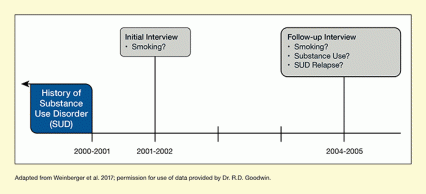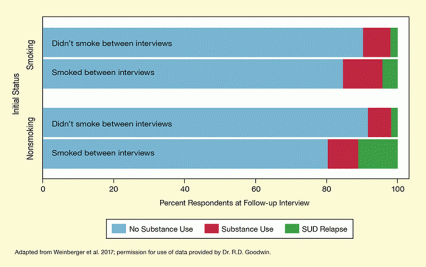This research:
- Found that cigarette smoking increased the likelihood of relapse among people in recovery from substance use disorder (SUD).
- Suggests that helping patients quit and remain abstinent from smoking may improve their chances for sustained recovery from use of other drugs.
Dr. Andrea H. Weinberger of the Ferkauf Graduate School of Psychology, Yeshiva University; Dr. Renee D. Goodwin of the Graduate School of Public Health and Health Policy, City University of New York; and colleagues analyzed data provided by 5,515 people who responded to the National Epidemiologic Survey on Alcohol and Related Conditions (NESARC) in 2001–2002 and again in 2004–2005. All of these people had a history of SUD but who were in remission from SUD and abstinent from drug use at the initial interview (Figure 1).
The researchers found that people who smoked cigarettes at the initial interview and who were still smoking 3 years later were about 1.5 times more likely to use drugs and twice as likely to have SUD at follow-up than those who quit smoking. Among nonsmokers at the initial interview, those who had started to smoke between interviews were almost 5 times more likely to report substance use at the follow-up compared with those who did not smoke (Figure 2).
Heavier smokers were even more likely to relapse to SUD. Among smokers at the initial interview, the odds of relapse increased by 0.7 percent for each cigarette smoked per day 3 years later. Among nonsmokers at the initial interview, the odds of relapse increased by 2.4 percent for each cigarette smoked per day 3 years later.
The researchers cite possible explanations why cigarette smoking might increase the likelihood of SUD relapse:
- Cigarette smoking often accompanies illicit drug use, and cigarettes may serve as a drug cue and relapse trigger.
- Some studies have linked nicotine exposure to cravings for stimulants and opiates.
Smoking and SUD Treatment
Smoking is pervasive among people with SUD, and some clinical lore and public opinion posit that concurrent smoking cessation is too difficult for patients struggling to abstain from substance use. It has even been suggested that smoking may help patients with SUD achieve early abstinence. However, this study and others indicate that patients may do better if treatment programs address smoking cessation and treatment for other substance use simultaneously.
“The perception that cigarette use helps with remaining abstinent from alcohol and other drugs has fostered a culture of smoking among this patient population,” Dr. Goodwin says. “So far, the bulk of evidence suggests that concurrent smoking cessation and substance use treatment is the most beneficial approach,” Dr. Goodwin notes.
Dr. Heather L. Kimmel, Health Scientist Administrator of NIDA’s Epidemiology Research Branch, agrees, adding, “Even though various substances have different pharmacological mechanisms, all drugs of abuse ultimately affect the same reward pathway. Abstinence from all of them will help the patient move to a new physiological state and, hopefully, a new mental state as well.”
This study was supported by NIH grant DA20892.
- Text Description of Figure 1
-
The figure illustrates the study design, which included two assessments indicated by the gray boxes. The horizontal x-axis shows the time line of the study. The dark blue box on the left indicates a history of substance use disorder (SUD) prior to the 2000–2001. The tick mark 2001–2002 and the gray box above it indicate the initial interview of the study, during which respondents were asked about their smoking status. The tick mark at 2004–2005 and the gray box above it indicate the follow-up interview, during which respondents were asked about their smoking status, substance use status, and relapse to SUD.
- Text Description of Figure 2
-
This bar chart illustrates the substance use of respondents in the study at the follow-up interview that was conducted 3 years after the initial interview, depending on their smoking status at the initial interview. The horizontal x-axis shows the percentage of respondents at the follow-up interview from 0% to 100%. The vertical y-axis indicates the smoking status (smoking vs. nonsmoking) at the initial interview. The colors of the bars indicate the substance use status at the follow-up interview, with blue indicating no substance use, red indicating substance use, and green indicating relapse to SUD. Among respondents who smoked at the initial interview but didn’t smoke between interviews (first bar), approximately 90 percent had no substance use, approximately 7.5 percent reported substance use, and approximately 2 percent had relapsed to SUD at the follow-up interview. Among respondents who smoked at the initial interview and continued to smoke between interviews (second bar), approximately 85 percent had no substance use, 11 percent reported substance use, and approximately 4 percent had relapsed to SUD at the follow-up interview. Among respondents who didn’t smoke at the initial interview and also didn’t smoke between the interviews (third bar), about 92 percent reported no substance use, about 7 percent reported substance use, and less than 2 percent had relapsed to SUD at the follow-up interview. Among respondents who did not smoke at the initial interview but initiated smoking between interviews (fourth bar), about 80 percent had no substance use, approximately 9 percent reported substance use, and approximately 11 percent had SUD at the follow-up interview.
Source:
- Weinberger, A.H., Platt, J., Esan, H., et al. Cigarette smoking is associated with increased risk of substance use disorder relapse: A nationally representative, prospective longitudinal investigation. Journal of Clinical Psychiatry 78(2):e152-e160, 2017.


